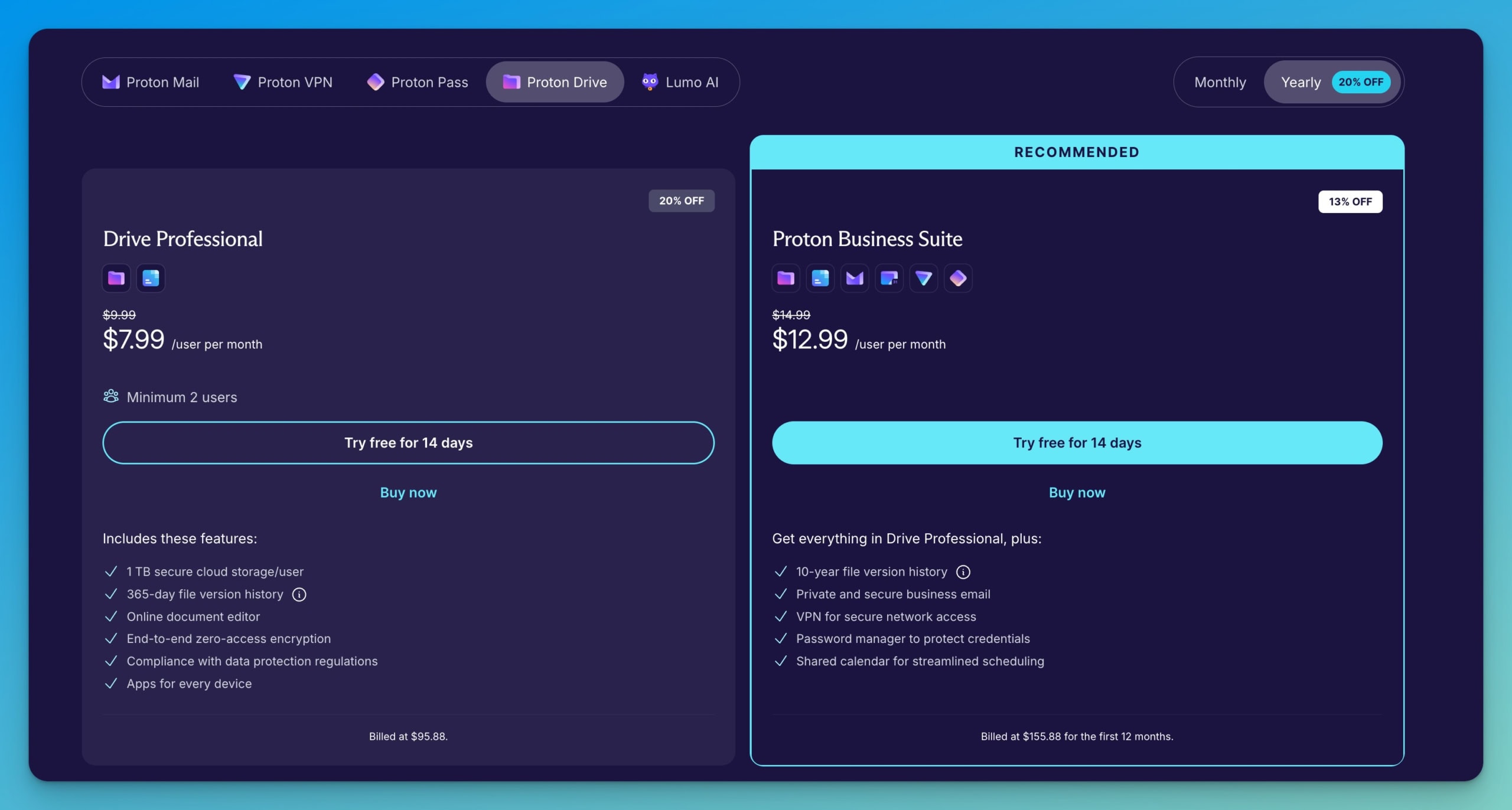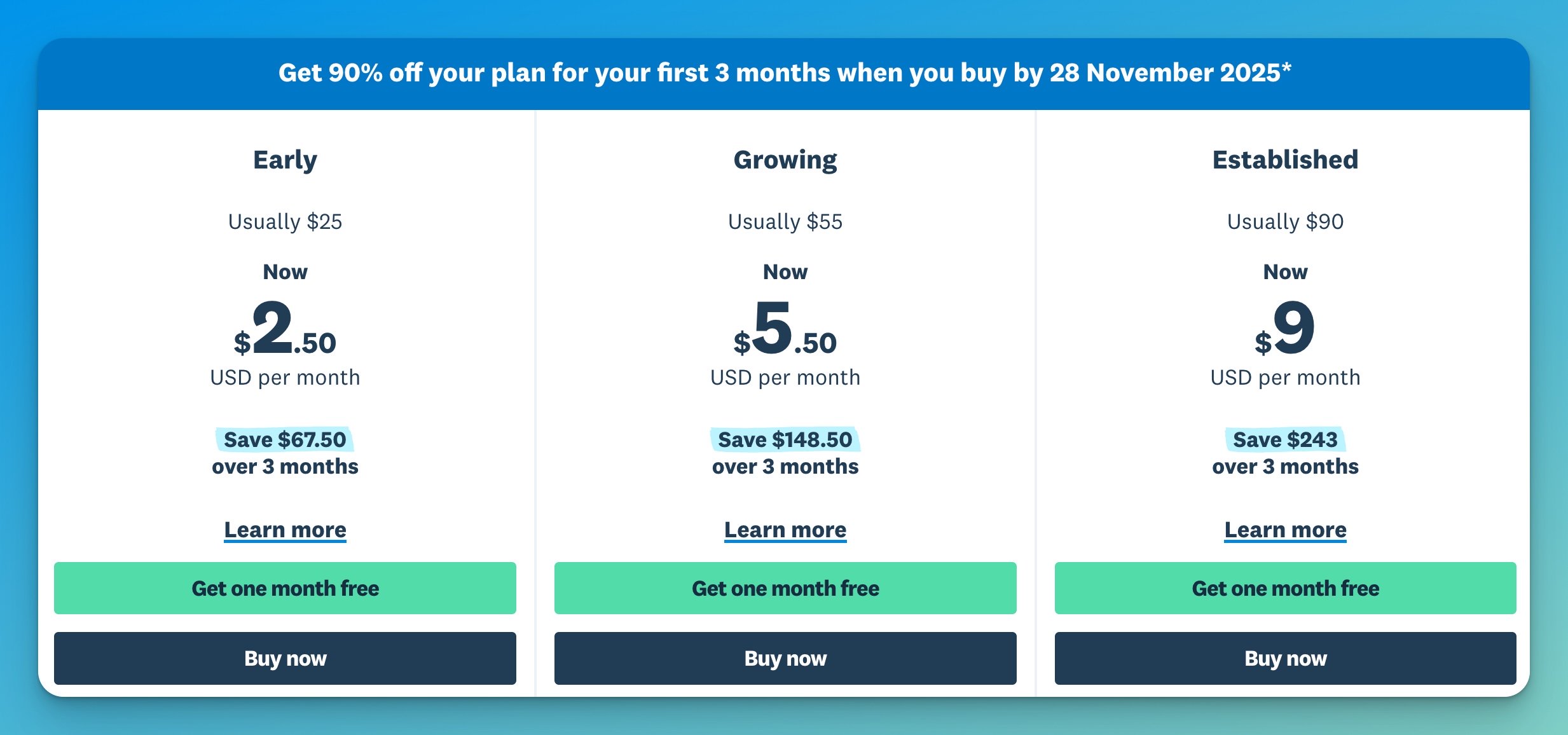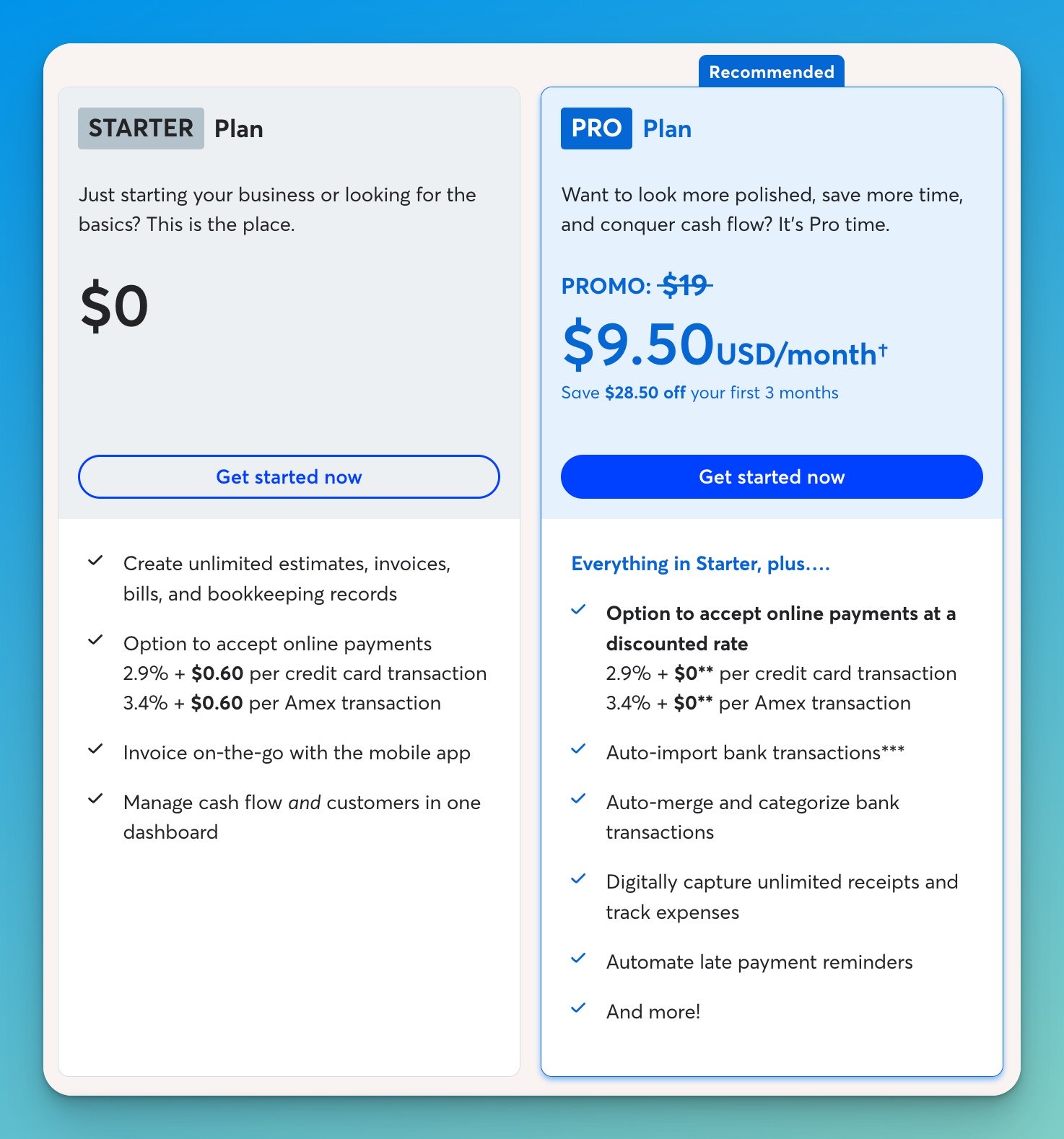Published: December 2, 2025 | Last updated: December 2, 2025
Key Takeaway: Both Tresorit and Proton Drive deliver end-to-end encrypted cloud storage, but they serve different needs. Tresorit offers advanced collaboration tools and granular permission controls ideal for regulated industries like healthcare and legal services. Proton Drive provides affordable, privacy-focused storage as part of a broader ecosystem—better suited for small businesses and individuals who value simplicity and cost efficiency. Your choice depends on whether you need enterprise-grade controls or straightforward, budget-friendly encryption.
Why Compare These Two?
When business owners ask about encrypted cloud storage, Tresorit and Proton Drive are consistently mentioned. Both services offer end-to-end encryption, zero-knowledge architecture, and strong privacy protections under Swiss law. The question isn't whether they're secure—they both are. The question is which one fits your specific needs and budget.
We work with businesses across Miami that handle sensitive information. Some need the detailed access controls and audit logs that Tresorit provides. Others want the simplicity and affordability of Proton Drive without sacrificing security. Let's break down the real differences so you can make an informed decision.
Security Architecture: Where They're Similar
Both platforms start with the same fundamental security approach. Files are encrypted on your device before they're uploaded. Your encryption keys stay with you—not on their servers. This means neither Tresorit nor Proton can access your files, even if they wanted to or were compelled by legal order. This zero-knowledge architecture is a cornerstone of a security-first infrastructure strategy for businesses handling sensitive information.
Tresorit has been around since 2011 and has extensive security credentials. They've undergone multiple independent security audits, including reviews by Computest and Ernst & Young that validated their zero-knowledge claims. They hold ISO 27001 certification and have earned the Digital Trust Label from the Swiss Digital Initiative.
Proton Drive, launched more recently by the team behind ProtonMail and ProtonVPN, also holds ISO 27001 certification and has completed SOC 2 Type II audits. The Proton Drive web application was independently audited by Securitum in 2021, though the mobile applications had not yet received public third-party audits as of our latest research.
For practical purposes, both services provide equivalent security for your data. The encryption is solid, the architecture is sound, and both companies have proven track records. When evaluating encrypted storage as part of your broader business cybersecurity strategy, the differences lie in features, usability, and compliance capabilities rather than fundamental security strength.
Pricing and Storage: The Cost Difference
This is where the comparison gets interesting. Proton Drive costs significantly less, but Tresorit includes features that justify the premium for certain use cases.
Proton Drive Business Pricing
For businesses, Proton offers Drive Professional at $7.99 per user per month (currently on sale from the regular $9.99 price). This plan includes 1TB of storage per user, with a minimum of 2 users required. You get secure cloud storage, 365-day file version history, an online document editor, end-to-end encryption, and compliance with data protection regulations.

The Proton Business Suite costs $12.99 per user per month (on sale from $14.99) and offers a better value for most businesses. This plan includes everything in Drive Professional plus encrypted email, calendar, VPN for secure network access, and a password manager. It's essentially a complete privacy-focused productivity suite with a 10-year file version history, rather than the 365-day limit.
Tresorit Business Pricing
Tresorit's Business plan costs $19 per user per month when billed annually, with a minimum of 3 users required. The team gets 6TB of shared storage (not per-user allocation), with a maximum file size of 15GB. This plan includes encrypted file sharing, version history, device sync, audit logs, custom branding, data residency options, and integrations with Microsoft, Google, and Okta.
For solopreneurs and consultants, Tresorit offers a Professional plan at $27.49 per month for a single user with 4TB of storage and a maximum file size of 10 GB. This works for individual professionals but isn't designed for team collaboration.

Enterprise customers get custom pricing with flexible user counts, storage amounts, and a maximum file size of 20 GB, plus advanced features such as personalized onboarding and dedicated support.
What This Means for Real Businesses
The pricing models differ fundamentally. Proton allocates storage per user (1TB each), while Tresorit provides a shared pool (6TB total for the team). For a 3-person team, Proton gives you 3TB of total storage, while Tresorit provides 6TB of shared storage.
Real-World Cost Example: Small Medical Practice
A three-person medical practice needs HIPAA-compliant storage for patient records. With Proton Drive Professional at $7.99 per user, they pay $23.97 monthly for 3TB of total storage (1TB per person). With Tresorit Business at $19 per user, the same practice pays $57 monthly for 6TB of shared storage.
Both include necessary compliance features and Business Associate Agreements. Tresorit costs 2.4 times more but provides double the storage and more advanced permission controls. Whether that premium is worth it depends on whether you need those enterprise features.
Collaboration Features and File Sharing
This is where Tresorit shows its enterprise focus. You can create secure links for files or folders with granular control: view-only permissions, download limits, password protection, and expiration dates. The platform supports detailed permission management—essential when different team members or external partners need varying levels of access to shared documents.
Tresorit's file request feature lets you collect files from external parties without requiring them to create an account. For legal firms, accounting practices, or any business regularly exchanging sensitive documents with clients, this streamlines workflows while maintaining security.
Proton Drive offers secure file sharing through email invites or shareable links. You can set passwords and expiration dates for shared links, and revoke access at any time. The functionality works well for straightforward sharing scenarios. However, the collaboration tools aren't as developed as Tresorit's—you won't find the same level of granular permission control or advanced workflow features.
For document collaboration, Proton recently added Proton Docs, their secure document editor. It allows real-time editing with end-to-end encryption maintained throughout. Tresorit integrates with Microsoft 365, including email encryption for Outlook and file sharing within Teams channels, which matters to businesses already invested in Microsoft's ecosystem.
Compliance and Regulatory Requirements
Both services meet GDPR requirements and offer HIPAA compliance with Business Associate Agreements. This is critical for healthcare providers, financial services firms, legal firms, and any organization that handles protected health information or sensitive personal data. Understanding these compliance requirements helps determine which platform best fits your regulatory needs.
HIPAA Compliance
Tresorit signs Business Associate Agreements with customers who use Business or Enterprise plans with 3 or more users. Their end-to-end encryption means that even if servers were compromised, the data remains unreadable—satisfying HIPAA's data breach notification requirements in most scenarios.
Proton also provides BAAs to business customers. Contact their legal team at legal@proton.ch with the subject “HIPAA BAA” to obtain a signed agreement. Their ISO 27001 certification and SOC 2 Type II audit provide additional assurance of compliance.
One practical difference: Tresorit offers data residency options, letting you choose whether data is stored in EU or US data centers. This matters for organizations with specific data sovereignty requirements. Proton stores all data in Switzerland, which benefits from strong privacy laws but offers less geographic flexibility.
Audit Logs and Administrative Controls
Tresorit provides detailed audit logs that show who accessed which files and when. This audit trail is essential for compliance reporting and investigating potential security incidents. The admin dashboard gives IT managers centralized control over users, permissions, and data access across the organization.
Proton Drive also provides audit logs and access controls to track file access and user activity. The administrative panel lets you manage users, enforce two-factor authentication, and monitor account activity. The functionality covers basic compliance needs but isn't as comprehensive as Tresorit's enterprise-focused tools.
Platform Support and Performance
Tresorit supports Windows, macOS, Linux, iOS, and Android with native applications for each platform. The sync performance is fast—we've deployed it for clients and haven't received complaints about slow uploads or sluggish syncing. The company promises 99.9% uptime, and in our experience, they deliver on that reliability.
Proton Drive offers apps for Windows, macOS, iOS, and Android. Linux support has been added, though it's newer than Tresorit's mature Linux client. The web interface works well across browsers. Performance is solid, though the service is younger and still adding features compared to Tresorit's more established platform.
Integration and Ecosystem
Tresorit positions itself as a standalone cloud storage solution with specific integrations for Microsoft 365. If you need an encrypted email, you'll need to integrate with existing email services using their Email Gateway feature.
Proton Drive is part of a complete privacy-focused ecosystem. If you subscribe to Proton Unlimited or Proton Business Suite, you get encrypted email, calendar, VPN, and password management, along with your storage. For businesses wanting a comprehensive privacy solution, this bundled approach provides significant value. You're not just getting storage—you're getting an entire secure productivity suite.
When to Choose Tresorit
Tresorit makes sense for organizations that need advanced collaboration features and granular control. Here are specific scenarios where it's the better choice:
Healthcare Practices: Medical offices handling patient records benefit from Tresorit's detailed audit logs, permission controls, and established HIPAA compliance track record.
Legal Firms: Law offices need granular control over who can access, edit, or share sensitive client documents. Tresorit's permission management and secure file requests streamline client document collection.
Financial Services: Accounting firms and financial advisors appreciate the detailed audit trails and compliance documentation that Tresorit provides out of the box.
Teams Needing Shared Storage Pools: If your 3-person team needs more than 3 TB, Tresorit's 6 TB shared model makes sense. The $33 monthly premium over Proton gets you double the storage plus enterprise controls.
Existing Microsoft 365 Users: Businesses already using Microsoft 365 benefit from Tresorit's direct integration with Outlook and Teams.
We recently worked with a law firm in Coral Gables handling sensitive business acquisitions. They needed to share documents with multiple parties under strict confidentiality—some partners could only view them, while others could download but not share them further. Tresorit's permission controls let them manage these complex requirements without creating separate document sets for each access level.
If you're in this category and need enterprise-grade controls, Tresorit provides the features that justify its premium pricing.
When to Choose Proton Drive
Proton Drive excels when you prioritize affordability, simplicity, and ecosystem integration. Consider Proton Drive if:
Small Teams (2-5 People): Startups and small businesses get secure storage without enterprise pricing. The Drive Professional plan at $7.99 per user provides 1TB of storage at less than half the cost of Tresorit.
Budget-Conscious Organizations: Nonprofits, educational projects, and bootstrapped startups need encryption without breaking the bank. Proton delivers strong security at accessible prices.
Privacy-First Companies: Businesses wanting to move away from Google Workspace or Microsoft 365 for privacy reasons appreciate Proton's complete ecosystem—email, storage, VPN, and calendar all encrypted by default.
Per-User Storage Needs: If each team member needs their own dedicated 1TB, Proton's per-user allocation model works better than Tresorit's shared pool.
Straightforward Collaboration: Organizations that need secure file storage and basic sharing without complex permission structures find Proton's interface intuitive and sufficient.
A marketing agency we consult with in Miami Beach uses Proton Business Suite. They're a six-person team handling client campaign materials—sensitive but not regulated data. They wanted to move away from Google Workspace due to privacy concerns. For $77.94 monthly ($12.99 per user), they get encrypted email, storage, VPN, and password management. It's cost-effective and covers all their privacy needs.
If you want strong security without enterprise complexity or pricing, Proton Drive delivers excellent value as part of its complete privacy ecosystem.
Storage Migration Considerations
Moving data from services such as Google Drive, Dropbox, or Microsoft OneDrive to encrypted storage requires careful planning. Both Tresorit and Proton provide straightforward upload processes, but neither offers automated migration tools from other cloud services.
For large migrations, Tresorit's mature sync clients handle bulk uploads efficiently. You can create a tresor (Tresorit's term for secure folders), point it at your existing data, and let it sync. The process is reliable for moving hundreds of gigabytes.
Proton Drive's sync functionality works well, but is newer. For smaller migrations (under 100GB), the process is smooth. Larger migrations might take longer as you're uploading through a younger infrastructure.
One practical tip: Start with a small test migration. Upload a few folders, test sharing with colleagues, and ensure the workflow matches your needs before moving everything. Both services offer free trials—Tresorit for 14 days and Proton's free tier. Use them.
For businesses concerned about keeping data entirely on-premises, a local NAS solution like Synology offers another encrypted storage alternative that keeps files within your physical control.
Support and Documentation
Tresorit provides comprehensive documentation and email support for all users. Enterprise customers get phone support—a meaningful differentiator when you need immediate help resolving an access issue or recovering a deleted file. Their knowledge base is extensive and regularly updated.
Proton offers email support for all users, with priority support for business customers. Their documentation is growing, but not as comprehensive as Tresorit's more mature knowledge base. The community forums are active, and Proton's team is responsive, but you won't get phone support on most plans.
Decision Framework
Here's how to choose based on your situation:
Choose Tresorit if:
- You operate in a regulated industry requiring detailed audit logs and granular permissions
- Your team needs more than 1TB per person (6TB shared pool accommodates this)
- Budget allows for $19 per user monthly (3-user minimum)
- You need Microsoft 365 integration
- Data residency options matter for compliance
- Enterprise features like custom branding and advanced admin controls are valuable
Choose Proton Drive if:
- Your team is 2-5 people with straightforward storage needs
- Budget is around $8 per user monthly for storage, or $13 per user for a complete privacy suite
- You want a complete privacy ecosystem (email, VPN, storage, calendar, password manager)
- Each team member needs a dedicated 1TB storage allocation
- Your collaboration requirements are basic file sharing and document editing
- You prefer a more straightforward interface without extensive permission configurations
Frequently Asked Questions
Can either service access my files?
No. Both Tresorit and Proton Drive use zero-knowledge encryption. Your files are encrypted on your device before upload. Neither company has access to your encryption keys, so they cannot decrypt your files even if legally compelled to do so.
What happens if I forget my password?
With zero-knowledge encryption, neither service can reset your password or recover your files if you forget your credentials. You'll lose access to your data. Both services strongly recommend storing your recovery key securely when you create your account.
Do both services work on mobile devices?
Yes. Both offer iOS and Android apps with offline access to synced files. Tresorit's mobile apps are more mature with additional features, while Proton Drive's mobile experience is newer but functional.
Can I share files with people who don't use the service?
Yes. Both services let you create secure, password-protected sharing links. Recipients can view or download files without creating an account. The files remain encrypted during transmission.
Which service is faster for syncing large files?
Both services deliver solid performance. Tresorit has been optimized for longer and handles large file syncs efficiently. Proton Drive performs well but may be slightly slower on initial large uploads, as its infrastructure is newer.
Are there file size limits?
Yes. Tresorit Business plans support files up to 15GB, Professional (solo) supports up to 10GB, and Enterprise supports up to 20GB. Proton Drive supports files up to 25GB on paid plans, with smaller limits on free accounts.
Can I use either service for website backups?
Yes, both work for encrypted backups. However, dedicated backup solutions like Acronis Cyber Protect or iDrive might be more efficient for automated website backups. These encrypted storage services work better for active file storage and sharing.
Do both services support two-factor authentication?
Yes. Both Tresorit and Proton Drive support two-factor authentication for additional account security. This is essential for protecting access to your encrypted storage.
The Bottom Line
Neither service is universally better. Tresorit excels for organizations needing enterprise-grade collaboration tools, detailed permission controls, and comprehensive audit capabilities. The higher price reflects features that matter for regulated industries and larger teams with complex workflows.
Proton Drive delivers strong security at accessible prices, particularly valuable for small teams and privacy-conscious businesses. The bundled ecosystem approach—combining email, storage, VPN, and calendar—provides comprehensive privacy protection without enterprise pricing.
For most small businesses (under 10 people) with straightforward storage needs, Proton Drive offers better value. For regulated industries, teams needing shared storage pools over 3TB, or organizations requiring granular access controls, Tresorit justifies its premium.
The best approach: Try both. Use Proton's free tier and Tresorit's 14-day trial to test the interfaces, upload some files, and share documents with colleagues. The right choice becomes clear when you actually use the platforms in your workflow.
Ready to protect your sensitive data?
Need help implementing encrypted storage for your business? We work with companies across Miami to deploy secure cloud solutions that meet compliance requirements without overwhelming small teams. Contact us to discuss your specific needs.
Disclosure: iFeelTech participates in affiliate programs for Tresorit and Proton. We may earn a commission when you purchase through our links at no additional cost to you. Our recommendations are based on our professional experience working with businesses that implement encrypted cloud storage solutions.


